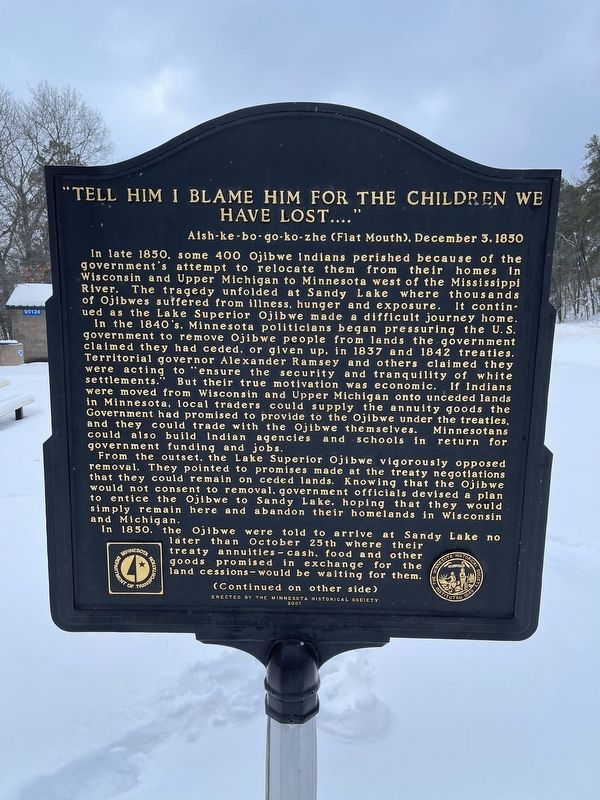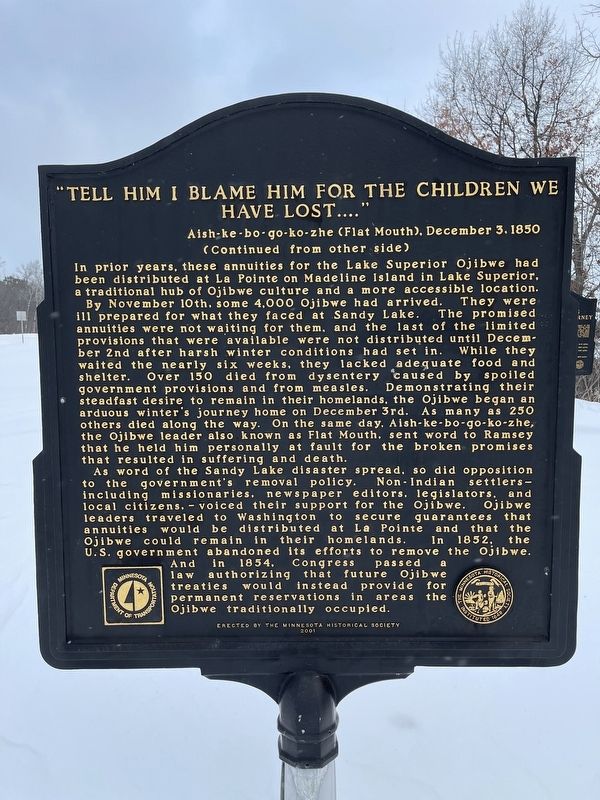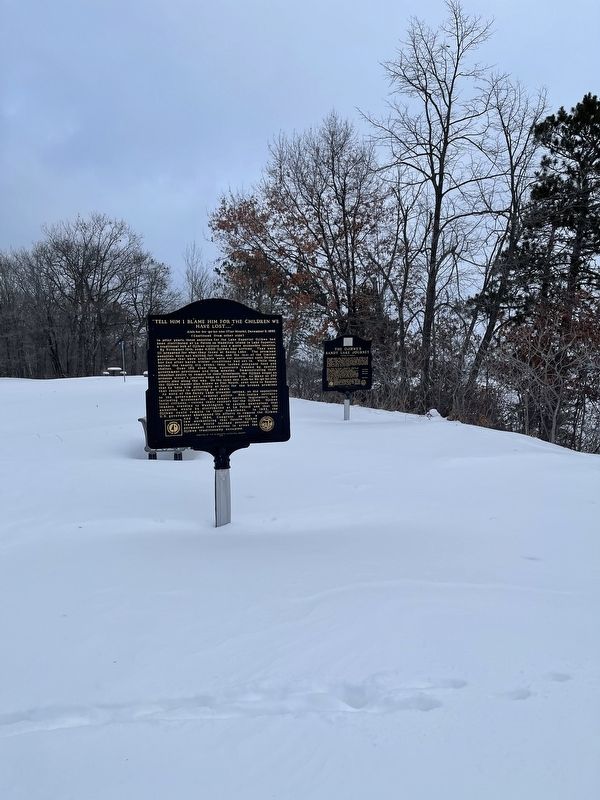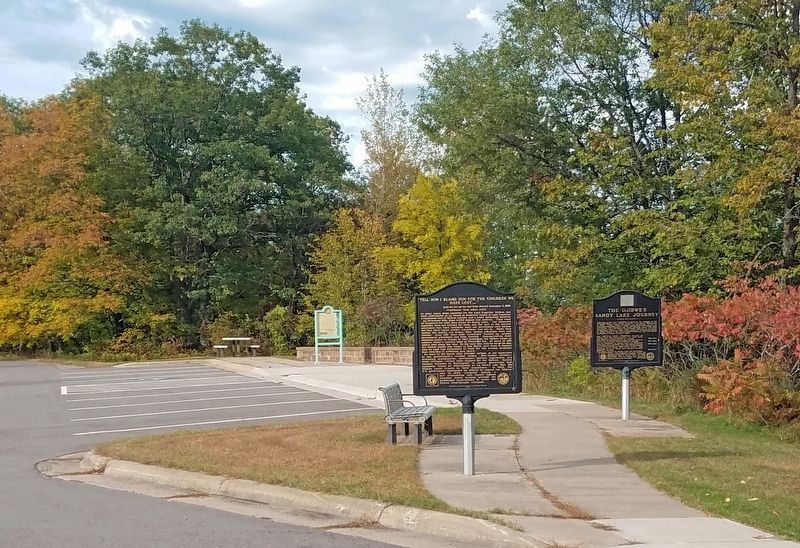Near Libby in Aitkin County, Minnesota — The American Midwest (Upper Plains)
"Tell him I blame him for the children we have lost...."
Aish-ke-bo-go-ko-zhe (Flat Mouth), December 3, 1850
Inscription.
In late 1850, some 400 Ojibwe Indians perished because of the government’s attempt to relocate them from their homes in Wisconsin and Upper Michigan to Minnesota west of the Mississippi River. The tragedy unfolded at Sandy Lake where thousands of Ojibwes suffered from illness, hunger and exposure. It continued as the Lake Superior Ojibwe made a difficult journey home.
In the 1840’s, Minnesota politicians began pressuring the U.S. government to remove Ojibwe people from lands the government claimed they had ceded, or given up, in 1837 and 1842 treaties. Territorial governor Alexander Ramsey and others claimed they were acting to “ensure the security and tranquility of white settlements.” But their true motivation was economic. If Indians were moved from Wisconsin and Upper Michigan onto unceded lands in Minnesota, local traders could supply the annuity goods the Government had promised to provide to the Ojibwe under the treaties, and they could trade with the Ojibwe themselves. Minnesotans could also build Indian agencies and schools in return for government funding and jobs.
From the outset, the Lake Superior Ojibwe vigorously opposed removal. They pointed to promises made at the treaty negotiations that they could remain on ceded lands. Knowing that the Ojibwe would not consent to removal, government officials devised a plan to entice the Ojibwe to Sandy Lake, hoping that they would simply remain here and abandon their homelands in Wisconsin and Michigan.
In 1850, the Ojibwe were told to arrive at Sandy Lake no later than October 25th where their treaty annuities - cash, food and other goods promised in exchange for the land cessions- would be waiting for them.
In prior years, these annuities for the Lake Superior Ojibwe had been distributed at La Pointe on Madeline Island in Lake Superior, a traditional hub of Ojibwe culture and a more accessible location.
By November 10th, some 4,000 Ojibwe had arrived. They were ill prepared for what they faced at Sandy Lake. The promised annuities were not waiting for them, and the last of the limited provisions that were available were not distributed until December 2nd after harsh winter conditions set in. While they waited the nearly six weeks, they lacked adequate food and shelter. Over 150 died from dysentery caused by spoiled government provisions and from measles. Demonstrating their steadfast desire to remain in their homelands, the Ojibwe began an arduous winter’s journey home on December 3rd. As many as 250 others died along the way. On the same day, Aish-ke-bo-go-ko-zhe, the Ojibwe leader also known as Flat Mouth, sent word to Ramsey that he held him personally at fault for the broken promises that resulted
in suffering and death.
As word of the Sandy Lake disaster spread, so did opposition to the government’s removal policy. Non-Indian settlers—including missionaries, newspaper editors, legislators, and local citizens—voiced their support for the Ojibwe. Ojibwe leaders traveled to Washington to secure guarantees that annuities would be distributed at La Pointe and that the Ojibwe could remain in their homelands. In 1852, the U.S. government abandoned its efforts to remove the Ojibwe. And in 1854, Congress passed a law authorizing that future Ojibwe treaties would instead provide for permanent reservations in areas the Ojibwe traditionally occupied.
Erected 2001 by the Minnesota Historical Society.
Topics. This historical marker is listed in these topic lists: Civil Rights • Industry & Commerce • Native Americans • Settlements & Settlers. A significant historical date for this entry is October 25, 1850.
Location. 46° 46.441′ N, 93° 19.609′ W. Marker is near Libby, Minnesota, in Aitkin County. Marker can be reached from State Highway 65, 0.6 miles 224th Place, on the right when traveling north. Marker is located at the Big Sandy Lake Wayside Rest Area. Touch for map. Marker is at or near this postal address: 52468 Hwy 65, McGregor MN 55760, United States of America. Touch for directions.
Other nearby markers. At least 5 other markers are within 12 miles of this marker, measured
as the crow flies. The Ojibwe's Sandy Lake Journey (a few steps from this marker); Big Sandy Lake Reservoir (within shouting distance of this marker); Where River Roads Met (within shouting distance of this marker); Sandy Lake Post (approx. one mile away); Glacial Lake Aitkin / Peat (approx. 11.6 miles away).
Additional keywords. forced removal
Credits. This page was last revised on July 25, 2023. It was originally submitted on September 29, 2022, by Liz Koele of St. Paul, Minnesota. This page has been viewed 216 times since then and 41 times this year. Photos: 1, 2, 3. submitted on September 29, 2022, by Liz Koele of St. Paul, Minnesota. 4. submitted on July 22, 2023, by McGhiever of Minneapolis, Minnesota. • Devry Becker Jones was the editor who published this page.



